Analyses of MODIS Land Cover/Use and Wildfires in Italian Regions Since 2001
Abstract
1. Introduction
- Demonstrating the distribution of each land cover/use type within each Italian region by boxplots, utilizing MOD12Q1 images for 2001–2023;
- Estimating linear trends and their statistical significance for each land cover/use type within each Italian administrative region for 2001–2023;
- Illustrating the monthly MODIS burned area and GPM precipitation time series for each Italian region in the 2001–2020 period and estimating the correlation between them;
- Classifying and depicting the burned areas based on elevation ranges for each region;
- Demonstrating correlation results between vegetation and land surface temperature and between vegetation and precipitation for Italian regions for 2001–2020;
- Comparing the results with the results of other studies and discussing the potential impact of land cover/use change on ecosystems.
2. Materials and Methods
2.1. Study Region
2.2. Datasets and Preprocessing
2.3. Boxplot
2.4. Mann–Kendall Analysis and Sen’s Slope Estimator
2.5. Pearson’s Correlation Method
3. Results
3.1. Distributions of Land Cover/Use Types
3.2. Trend Analysis of Land Cover/Use Time Series
3.3. Spatial Distribution of Wildfires Across Italy Since 2001
3.4. Temporal Distribution of Wildfires and Precipitation in Italian Regions Since 2001
3.5. Correlation Results for Precipitation and Burned Areas
3.6. Burned Area Distribution for Elevation Ranges
4. Discussion
4.1. Potential Driving Factors of Wildfires in Italy
4.2. Ecological and Planning Implications
4.3. Limitations and Recommendations
5. Conclusions
Author Contributions
Funding
Data Availability Statement
Acknowledgments
Conflicts of Interest
References
- Berčák, R.; Holuša, J.; Kaczmarowski, J.; Tyburski, Ł.; Szczygieł, R.; Held, A.; Vacik, H.; Slivinský, J.; Chromek, I. Fire Protection Principles and Recommendations in Disturbed Forest Areas in Central Europe: A Review. Fire 2023, 6, 310. [Google Scholar] [CrossRef]
- González-Marín, A.; Garrido-Cumbrera, M. Assessing urban vegetation inequalities: Methodological insights and evidence. Ecol. Inform. 2025, 86, 102987. [Google Scholar] [CrossRef]
- Murgia, I.; Vitali, A.; Giadrossich, F.; Tonelli, E.; Baglioni, L.; Cohen, D.; Schwarz, M.; Urbinati, C. Effects of Land Cover Changes on Shallow Landslide Susceptibility Using SlideforMAP Software (Mt. Nerone, Italy). Land 2024, 13, 1575. [Google Scholar] [CrossRef]
- Patacca, M.; Lindner, M.; Lucas-Borja, M.E.; Cordonnier, T.; Fidej, G.; Gardiner, B.; Hauf, Y.; Jasinevičius, G.; Labonne, S.; Linkevičius, E.; et al. Significant increase in natural disturbance impacts on European forests since 1950. Glob. Change Biol. 2023, 29, 1359–1376. [Google Scholar] [CrossRef]
- Ghaderpour, E.; Mazzanti, P.; Scarascia Mugnozza, G.; Bozzano, F. Coherency and phase delay analyses between land cover and climate across Italy via the least-squares wavelet software. Int. J. Appl. Earth Obs. Geoinf. 2023, 118, 103241. [Google Scholar] [CrossRef]
- Chen, S.; Zhuang, Q.; Taheripour, F.; Yuan, Y.; Benavidez, L. Assessment of global land cover changes using satellite data: Intermittent and long-term land cover changes from 2001 to 2020. Environ. Res. Lett. 2025, 20, 034045. [Google Scholar] [CrossRef]
- Salavati, G.; Saniei, E.; Ghaderpour, E.; Hassan, Q.K. Wildfire Risk Forecasting Using Weights of Evidence and Statistical Index Models. Sustainability 2022, 14, 3881. [Google Scholar] [CrossRef]
- Farid, A.; Alam, M.K.; Goli, V.S.N.S.; Akin, I.D.; Akinleye, T.; Chen, X.; Cheng, Q.; Cleall, P.; Cuomo, S.; Foresta, V.; et al. A Review of the Occurrence and Causes for Wildfires and Their Impacts on the Geoenvironment. Fire 2024, 7, 295. [Google Scholar] [CrossRef]
- Culler, E.S.; Livneh, B.; Rajagopalan, B.; Tiampo, K.F. A data-driven evaluation of post-fire landslide susceptibility. Nat. Hazards Earth Syst. Sci. 2023, 23, 1631–1652. [Google Scholar] [CrossRef]
- Akosah, S.; Gratchev, I. Systematic Review of Post-Wildfire Landslides. GeoHazards 2025, 6, 12. [Google Scholar] [CrossRef]
- Fan, D.; Wang, M.; Liang, T.; He, H.; Zeng, Y.; Fu, B. Estimation and trend analysis of carbon emissions from forest fires in mainland China from 2011 to 2021. Ecol. Inform. 2024, 81, 102572. [Google Scholar] [CrossRef]
- Hardtke, L.A.; Blanco, P.D.; del Valle, H.F.; Metternicht, G.I.; Sione, W.F. Semi-automated mapping of burned areas in semi-arid ecosystems using MODIS time-series imagery. Int. J. Appl. Earth Obs. Geoinf. 2015, 38, 25–35. [Google Scholar] [CrossRef]
- Dadkhah, H.; Rana, D.; Ghaderpour, E.; Mazzanti, P. Analyzing wildfire patterns and climate interactions in Campania, Italy: A multi-sensor remote sensing study. Ecol. Inf. 2025, 90, 103249. [Google Scholar] [CrossRef]
- Lizundia-Loiola, J.; Franquesa, M.; Boettcher, M.; Kirches, G.; Pettinari, M.L.; Chuvieco, E. Implementation of the Burned Area Component of the Copernicus Climate Change Service: From MODIS to OLCI Data. Remote Sens. 2021, 13, 4295. [Google Scholar] [CrossRef]
- Moritz, M.A.; Parisien, M.-A.; Batllori, E.; Krawchuk, M.A.; Van Dorn, J.; Ganz, D.J.; Hayhoe, K. Climate change and disruptions to global fire activity. Ecosphere 2012, 3, 49. [Google Scholar] [CrossRef]
- Liu, Y.; Stanturf, J.; Goodrick, S. Wildfire potential evaluation during a drought event with a regional climate model and NDVI. Ecol. Inform. 2010, 5, 418–428. [Google Scholar] [CrossRef]
- Zahura, F.T.; Bisht, G.; Li, Z.; McKnight, S.; Chen, X. Impact of topography and climate on post-fire vegetation recovery across different burn severity and land cover types through random forest. Ecol. Inform. 2024, 82, 102757. [Google Scholar] [CrossRef]
- Pereira, M.G.; Gonçalves, N.; Amraoui, M. The Influence of Wildfire Climate on Wildfire Incidence: The Case of Portugal. Fire 2024, 7, 234. [Google Scholar] [CrossRef]
- Xepapadeas, P.; Douvis, K.; Kapsomenakis, I.; Xepapadeas, A.; Zerefos, C. Assessing the Link between Wildfires, Vulnerability, and Climate Change: Insights from the Regions of Greece. Sustainability 2024, 16, 4822. [Google Scholar] [CrossRef]
- Ghaderpour, E.; Masciulli, C.; Zocchi, M.; Bozzano, F.; Scarascia Mugnozza, G.; Mazzanti, P. Estimating Reactivation Times and Velocities of Slow-Moving Landslides via PS-InSAR and Their Relationship with Precipitation in Central Italy. Remote Sens. 2024, 16, 3055. [Google Scholar] [CrossRef]
- Tapiador, F.J.; Turk, F.J.; Petersen, W.; Hou, A.Y.; García-Ortega, E.; Machado, L.A.T.; Angelis, C.F.; Salio, P.; Kidd, C.; Huffman, G.J.; et al. Global precipitation measurement: Methods, datasets and applications. Atmos. Res. 2012, 104–105, 70–97. [Google Scholar] [CrossRef]
- Kirschbaum, D.; Stanley, T. Satellite-Based Assessment of Rainfall-Triggered Landslide Hazard for Situational Awareness. Earth’s Future 2018, 6, 505–523. [Google Scholar] [CrossRef] [PubMed]
- Ghaderpour, E.; Dadkhah, H.; Dabiri, H.; Bozzano, F.; Scarascia Mugnozza, G.; Mazzanti, P. Precipitation Time Series Analysis and Forecasting for Italian Regions. Eng. Proc. 2023, 39, 23. [Google Scholar] [CrossRef]
- Sulla-Menashe, D.; Gray, J.M.; Abercrombie, S.P.; Friedl, M.A. Hierarchical mapping of annual global land cover 2001 to present: The MODIS Collection 6 Land Cover product. Remote Sens. Environ. 2019, 222, 183–194. [Google Scholar] [CrossRef]
- Lizundia-Loiola, J.; Otón, G.; Ramo, R.; Chuvieco, E. A spatio-temporal active-fire clustering approach for global burned area mapping at 250 m from MODIS data. Remote Sens. Environ. 2020, 236, 111493. [Google Scholar] [CrossRef]
- Huffman, G.J.; Bolvin, D.T.; Braithwaite, D.; Hsu, K.; Joyce, R. NASA Global Precipitation Measurement (GPM) Integrated Multi-SatellitE Retrievals for GPM; NASA Goddard Earth Sciences Data and Information Services Center: Greenbelt, MD, USA, 2017. [Google Scholar] [CrossRef]
- McGill, R.; Tukey, J.W.; Larsen, W.A. Variations of box plots. Am. Stat. 1978, 32, 12–16. [Google Scholar] [CrossRef]
- Ghaderpour, E.; Mazzanti, P.; Bozzano, F.; Scarascia Mugnozza, G. Trend Analysis of MODIS Land Surface Temperature and Land Cover in Central Italy. Land 2024, 13, 796. [Google Scholar] [CrossRef]
- Khosravi, Y.; Homayouni, S.; Ouarda, T.B.M.J. Spatio-temporal evaluation of MODIS temperature vegetation dryness index in the Middle East. Ecol. Inform. 2024, 84, 102894. [Google Scholar] [CrossRef]
- Dash, P.; Shekhar, S.; Paul, V.; Feng, G. Influence of Land Use and Land Cover Changes and Precipitation Patterns on Groundwater Storage in the Mississippi River Watershed: Insights from GRACE Satellite Data. Remote Sens. 2024, 16, 4285. [Google Scholar] [CrossRef]
- Ratner, B. The correlation coefficient: Its values range between +1/−1, or do they? J. Target. Meas. Anal. Mark. 2009, 17, 139–142. [Google Scholar] [CrossRef]
- Warne, R.T. Correlation. In Statistics for the Social Sciences: A General Linear Model Approach; Cambridge University Press: Cambridge, UK, 2020; pp. 334–374. [Google Scholar] [CrossRef]
- Garbarino, M.; Morresi, D.; Urbinati, C.; Malandra, F.; Motta, R.; Sibona, E.M.; Vitali, A.; Weisberg, P.J. Contrasting land use legacy effects on forest landscape dynam-ics in the Italian Alps and the Apennines. Landsc. Ecol. 2020, 35, 2679–2694. [Google Scholar] [CrossRef]
- Ascoli, D.; Moris, J.V.; Marchetti, M.; Sallustio, L. Land use change towards forests and wooded land correlates with large and frequent wildfires in Italy. Ann. Silvic. Res. 2021, 46, 177–188. [Google Scholar] [CrossRef]
- Carabella, C.; Miccadei, E.; Paglia, G.; Sciarra, N. Post-Wildfire Landslide Hazard Assessment: The Case of The 2017 Montagna Del Morrone Fire (Central Apennines, Italy). Geosciences 2019, 9, 175. [Google Scholar] [CrossRef]
- Trucchia, A.; Meschi, G.; Fiorucci, P.; Gollini, A.; Negro, D. Defining Wildfire Susceptibility Maps in Italy for Understanding Seasonal Wildfire Regimes at the National Level. Fire 2022, 5, 30. [Google Scholar] [CrossRef]
- Lovreglio, R.; Leone, V.; Giaquinto, P.; Notarnicola, A. Wildfire cause analysis: Four case-studies in southern Italy. iForest 2010, 3, 8–15. [Google Scholar] [CrossRef]
- Malandra, F.; Vitali, A.; Morresi, D.; Garbarino, M.; Foster, D.E.; Stephens, S.L.; Urbinati, C. Burn Severity Drivers in Italian Large Wildfires. Fire 2022, 5, 180. [Google Scholar] [CrossRef]
- Baffo, F.; Desiato, F.; Fioravanti, G.; Frascehtti, P.; Perconti, W.; Toreti, A.; Morucci, S.; Pavan, V.; Cacciamani, C.; Stel, F.; et al. Gli Indicatori del Clima in Italia nel 2007; Agenzia per la Protezione Dell’ambiente e per i Servizi Tecnici: Roma, Italy, 2007. [Google Scholar]
- Desiato, F.; Fioravanti, G.; Fraschetti, P.; Perconti, W.; Piervitali, E.; Pavan, V. Gli Indicatori del Clima in Italia 2017; ISPRA—Istituto Superiore per la Protezione e la Ricerca Ambientale: Roma, Italy, 2018; ISBN 978-88-448-0904-1. [Google Scholar]
- Hidalgo, P.J.; Hernández, H.; Sánchez-Almendro, A.J.; López-Tirado, J.; Vessella, F.; Porras, R. Fragmentation and Connectivity of Island Forests in Agricultural Mediterranean Environments: A Comparative Study between the Guadalquivir Valley (Spain) and the Apulia Region (Italy). Forests 2021, 12, 1201. [Google Scholar] [CrossRef]
- Biswas, G.; Sengupta, A.; Alfaisal, F.M.; Alam, S.; Alharbi, R.S.; Jeon, B.-H. Evaluating the effects of landscape fragmentation on ecosystem services: A three-decade perspective. Ecol. Inf. 2023, 77, 102283. [Google Scholar] [CrossRef]
- Lozano, O.M.; Salis, M.; Ager, A.A.; Arca, B.; Alcasena, F.J.; Monteiro, A.T.; Finney, M.A.; Del Giudice, L.; Scoccimarro, E.; Spano, D. Assessing Climate Change Impacts on Wildfire Exposure in Mediterranean Areas. Risk Anal. 2017, 37, 1898–1916. [Google Scholar] [CrossRef]
- Ferrara, C.; Salvati, L.; Corona, P.; Romano, R.; Marchi, M. The background context matters: Local-scale socioeconomic conditions and the spatial distribution of wildfires in Italy. Sci. Total Environ. 2019, 654, 43–52. [Google Scholar] [CrossRef]
- Michetti, M.; Pinar, M. Forest Fires Across Italian Regions and Implications for Climate Change: A Panel Data Analysis. Environ. Resour. Econ. 2019, 72, 207–246. [Google Scholar] [CrossRef]
- Waldner, F.; Defourny, P. Where can pixel counting area estimates meet user-defined accuracy requirements? Int. J. Appl. Earth Obs. Geoinf. 2017, 60, 1–10. [Google Scholar] [CrossRef]
- Fusco, E.J.; Finn, J.T.; Abatzoglou, J.T.; Balch, J.K.; Dadashi, S.; Bradley, B.A. Detection rates and biases of fire observations from MODIS and agency reports in the conterminous United States. Remote Sens. Environ. 2019, 220, 30–40. [Google Scholar] [CrossRef]
- Katagis, T.; Gitas, I.Z. Assessing the Accuracy of MODIS MCD64A1 C6 and FireCCI51 Burned Area Products in Mediterranean Ecosystems. Remote Sens. 2022, 14, 602. [Google Scholar] [CrossRef]
- Gonzalez-Ibarzabal, J.; Franquesa, M.; Rodriguez-Montellano, A.; Bastarrika, A. Sentinel-2 Reference Fire Perimeters for the Assessment of Burned Area Products over Latin America and the Caribbean for the Year 2019. Remote Sens. 2024, 16, 1166. [Google Scholar] [CrossRef]
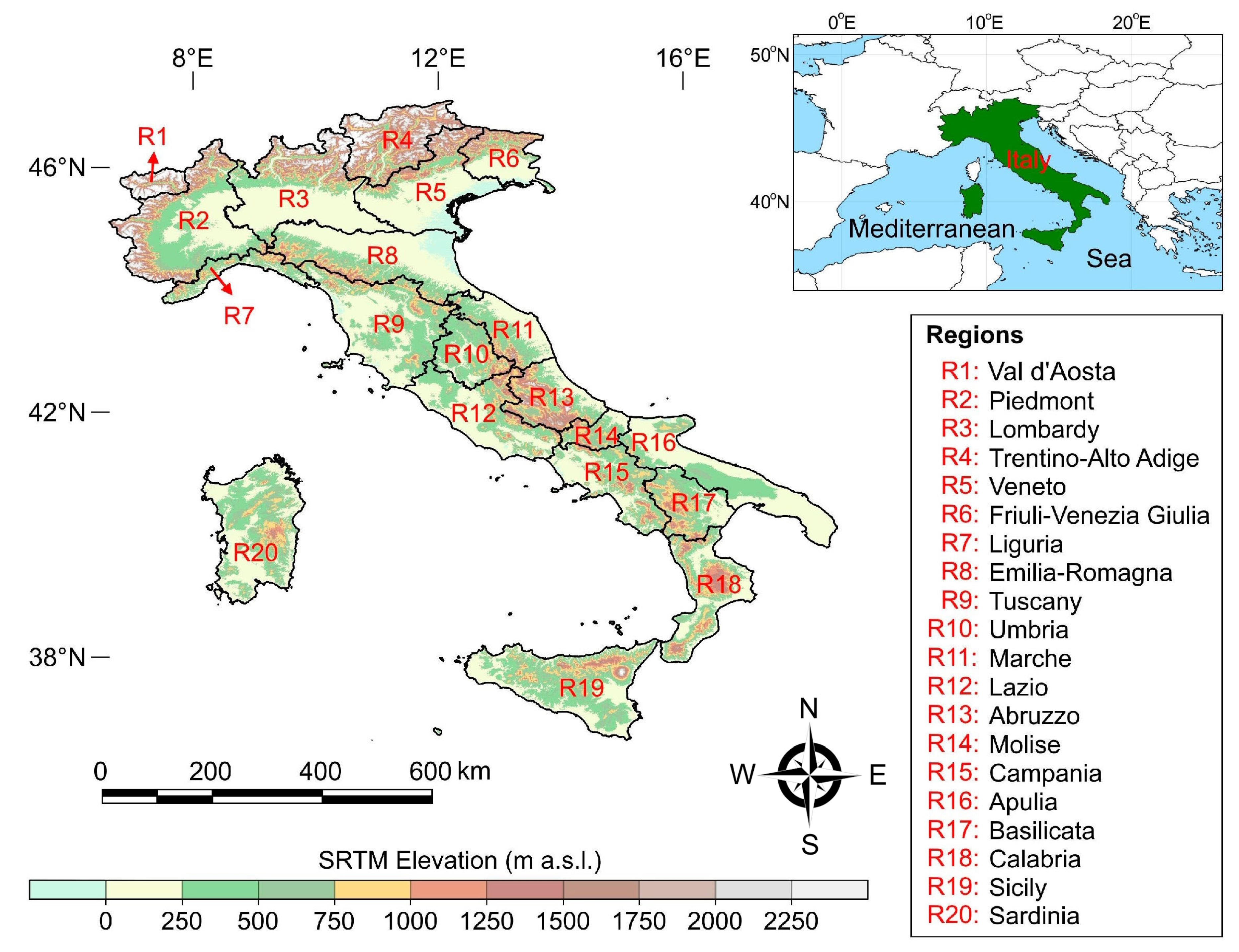
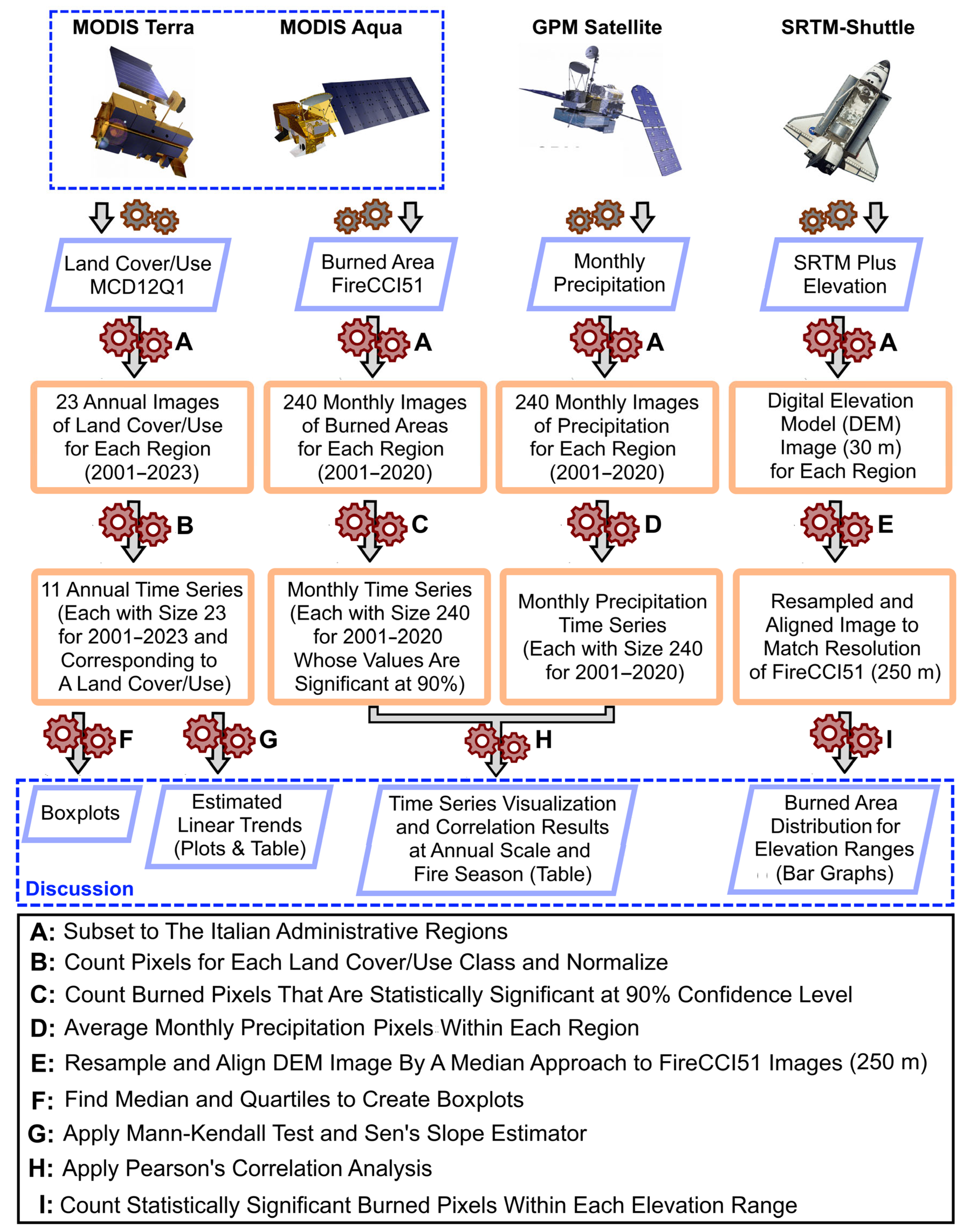


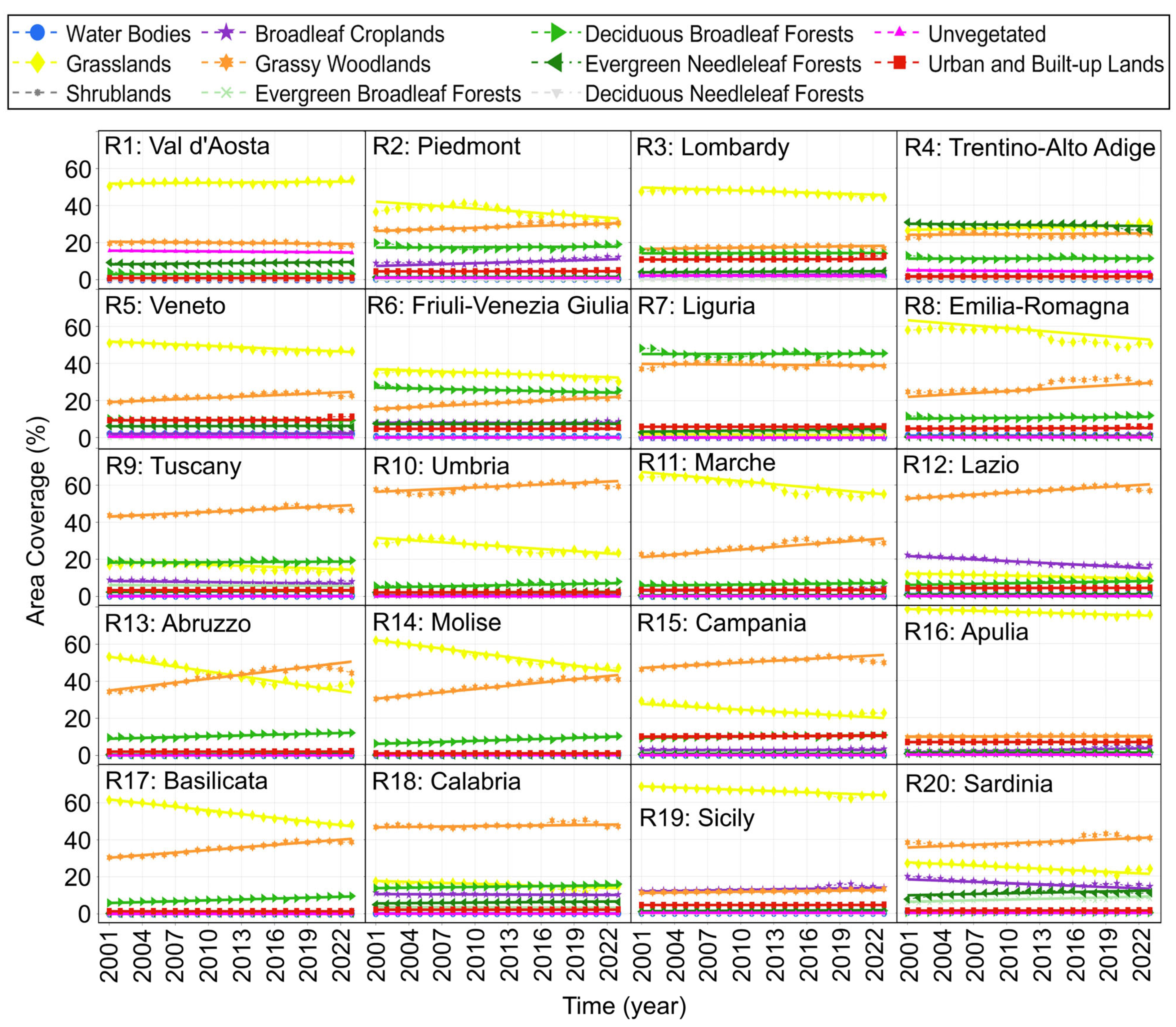
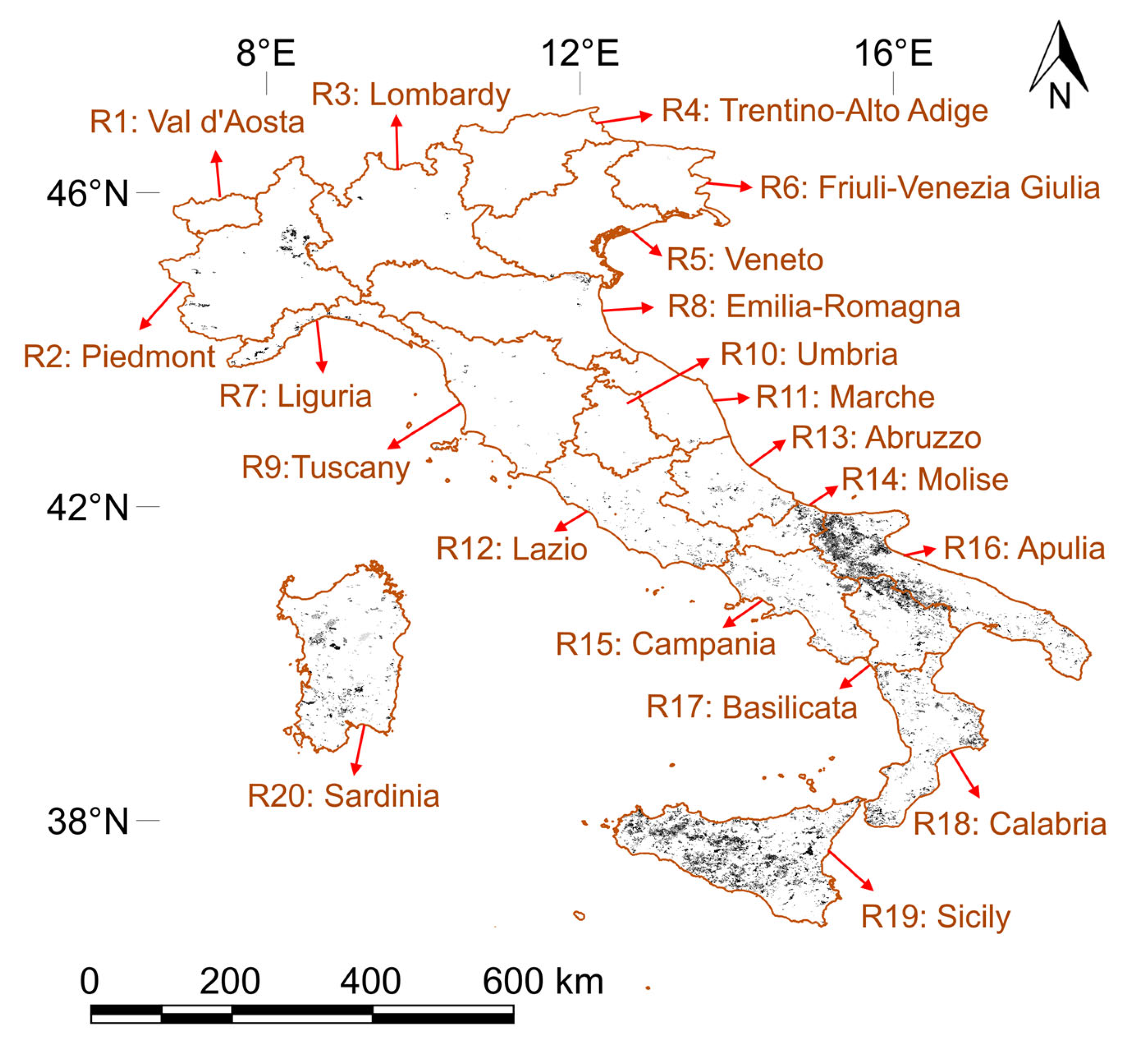
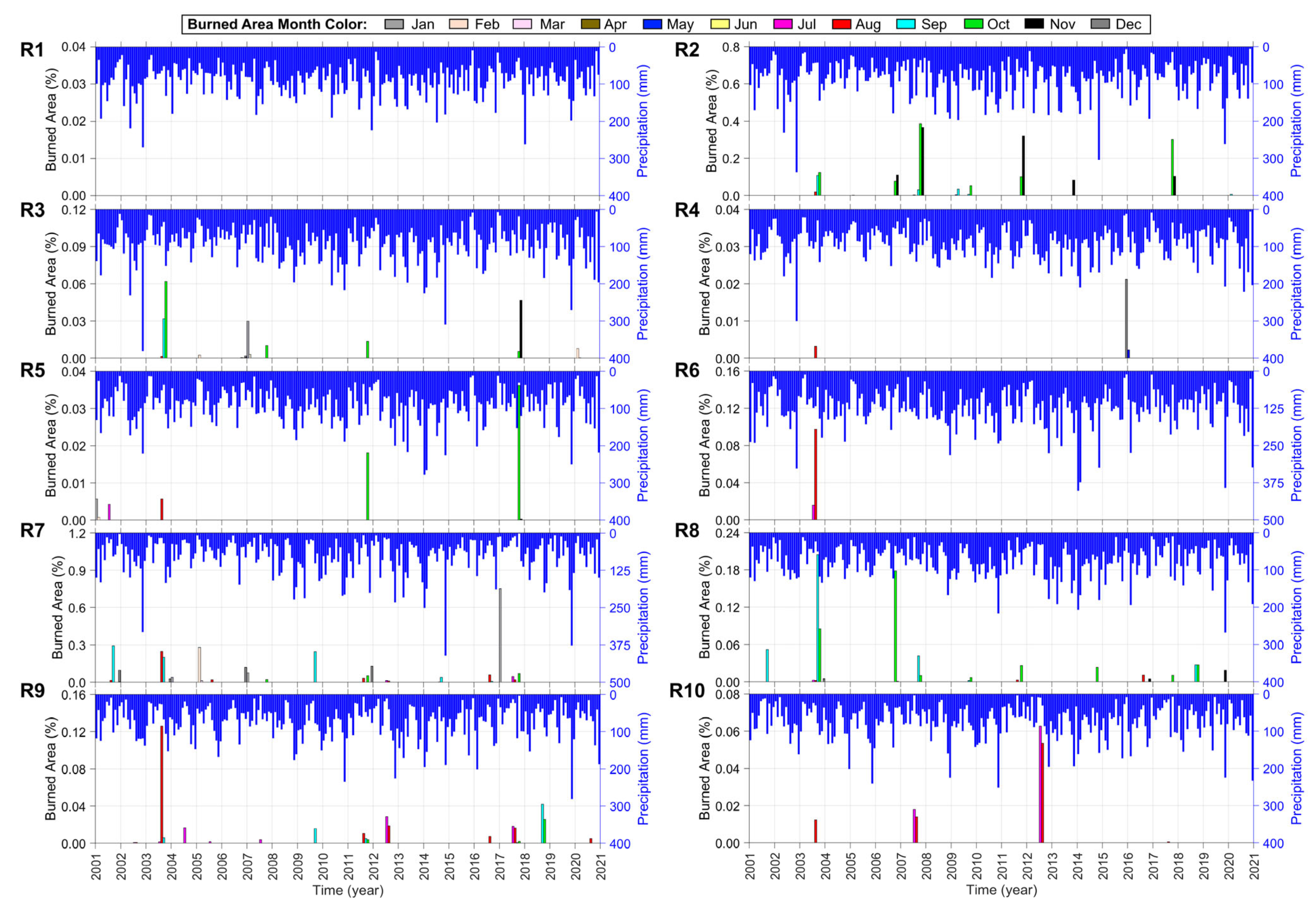
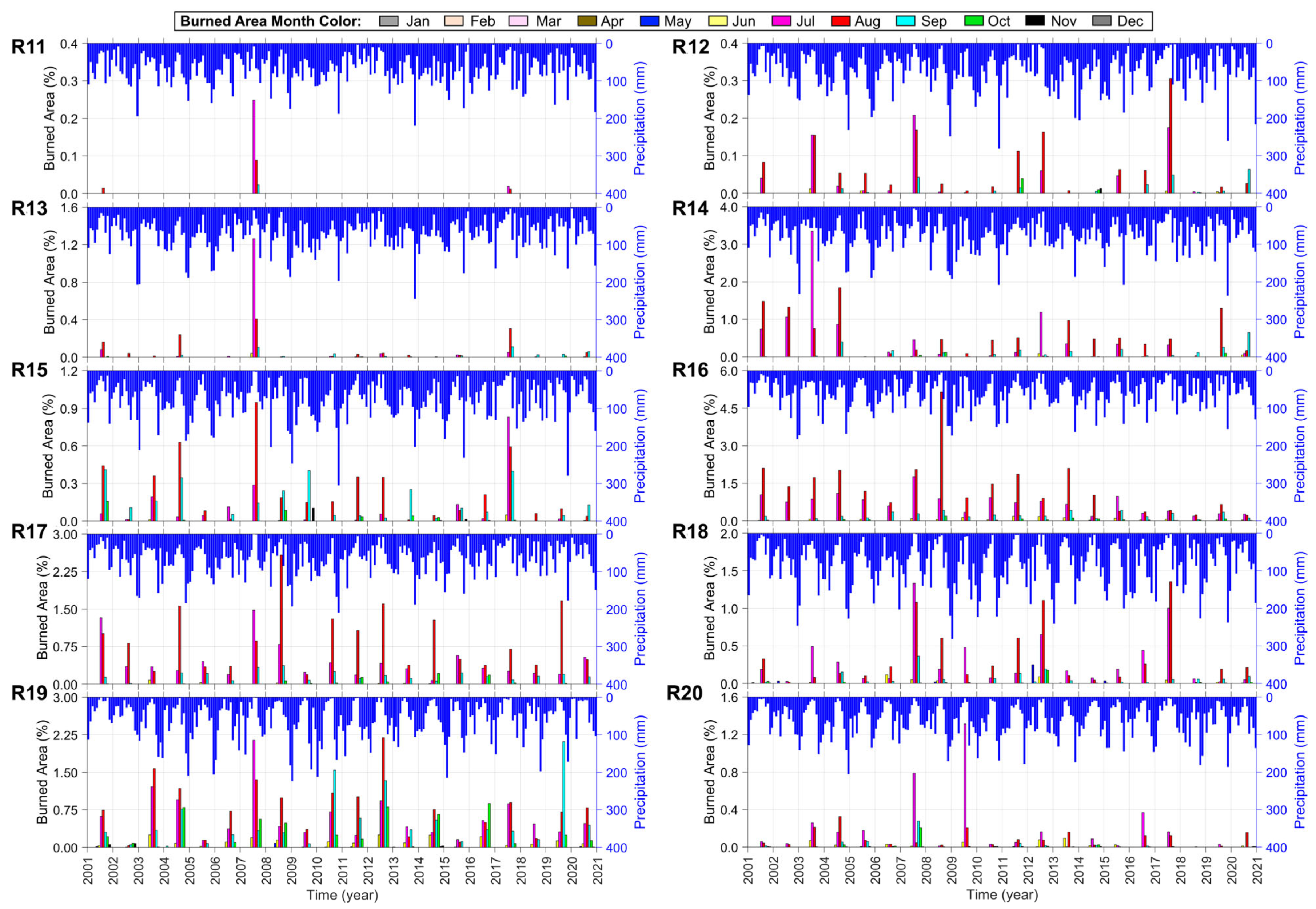
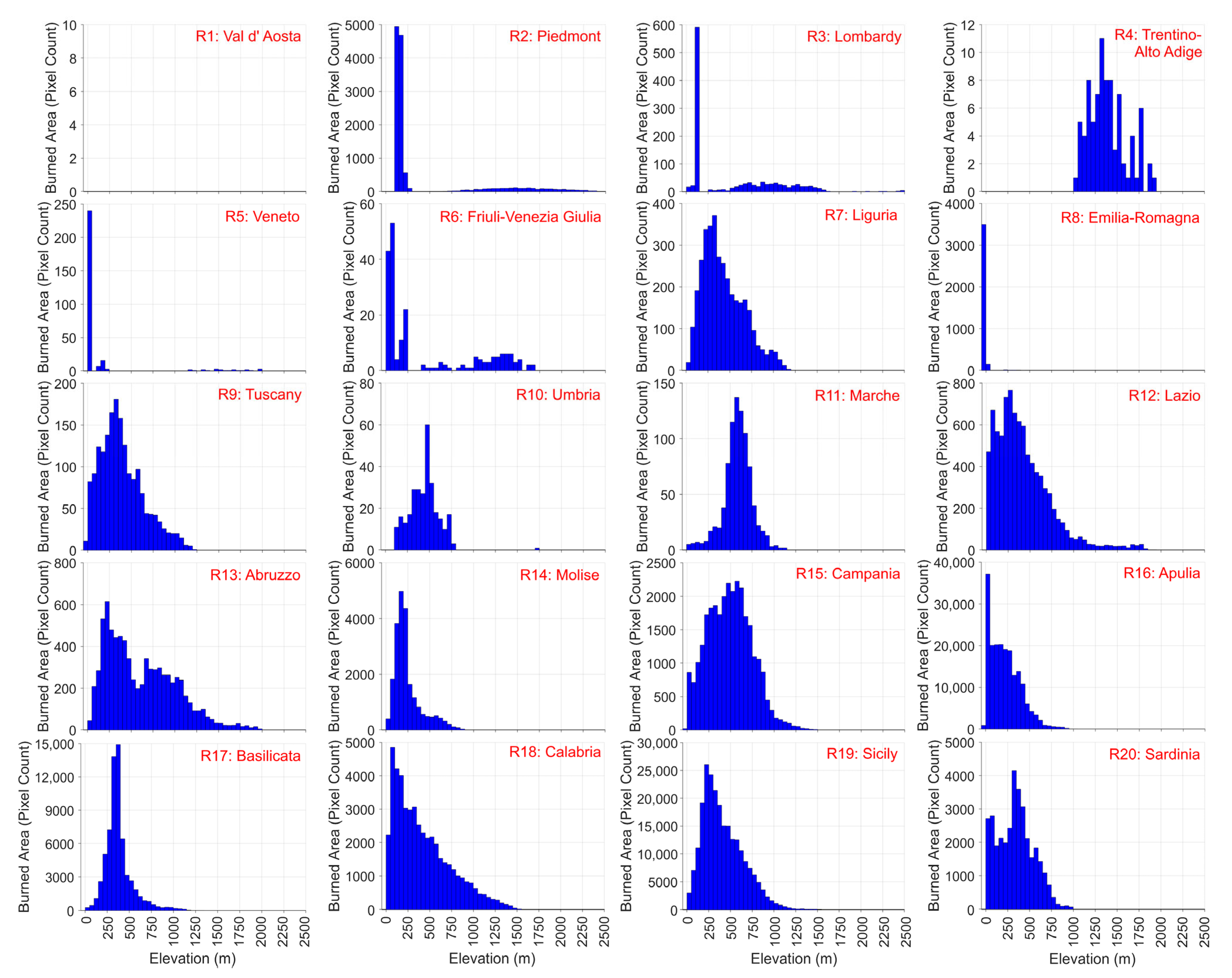
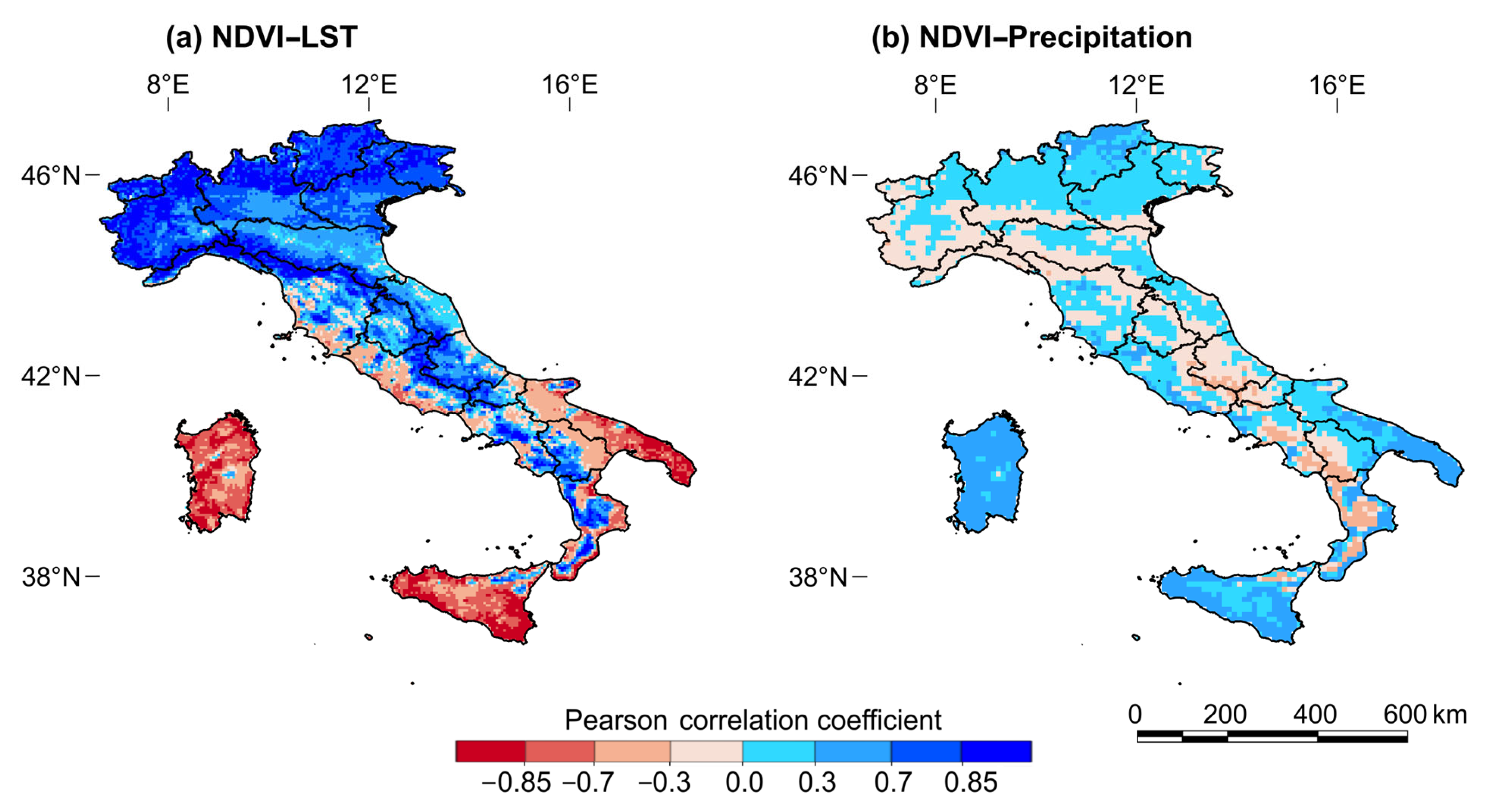
| Product Name | Spatial Resolution | Date | Description | Source |
|---|---|---|---|---|
| STRM Plus | 30 m | 2000 | Shuttle Radar Topography Mission (SRTM) plus—Digital Elevation Model (DEM) | https://doi.org/10.1029/2005RG000183 (accessed on 11 May 2025) |
| MCD12Q1 | 500 m | 2001–2023 Annual | MODIS Land Cover Type (11 classes) | https://doi.org/10.5067/MODIS/MCD12Q1.061 (accessed on 11 May 2025) |
| FireCCI51 | 250 m | 2001–2020 Monthly | MODIS Fire_cci Burned Area Pixel Product | https://doi.org/10.5285/58f00d8814064b79a0c49662ad3af537 (accessed on 11 May 2025) |
| GPM | 0.1 × 0.1 degree | 2001–2020 Monthly | Monthly Global Precipitation Measurement | https://doi.org/10.5067/GPM/IMERG/3B-MONTH/07 (accessed on 11 May 2025) |
| LST | 0.05 × 0.05 degree | 2001–2020 Monthly | Monthly Land Surface Temperature | https://doi.org/10.5067/MODIS/MOD11C3.061 (accessed on 11 June 2025) |
| NDVI | 250 m | 2001–2020 16-day | Normalized Difference Vegetation Index | https://doi.org/10.5067/MODIS/MOD13Q1.061 (accessed on 11 June 2025) |
| R | Water Bodies | Grasslands | Shrublands | Broadleaf Croplands | Grassy Woodlands | Evergreen Broadleaf Forests | Deciduous Broadleaf Forests | Evergreen Needleleaf Forests | Unvegetated | Urban and Built-Up Lands |
|---|---|---|---|---|---|---|---|---|---|---|
| 1 | 0.04 + 0.00 t | 51.87 + 0.05 t | 0.00 + 0.00 t | 0.09 + 0.00 **t | 20.50 − 0.05 **t | 00.00 − 0.00 t | 2.88 + 0.01 t | 8.25 + 0.06 **t | 15.64 − 0.04 **t | 0.83 + 0.00 **t |
| 2 | 0.39 + 0.00 **t | 42.11 − 0.41 **t | 0.02 + 0.00 **t | 7.36 + 0.17 **t | 26.30 + 0.19 **t | 0.00 + 0.00 t | 17.31 + 0.03 t | 1.25 + 0.01 **t | 1.01 − 0.01 **t | 4.45 + 0.00 **t |
| 3 | 1.95 + 0.00 **t | 49.67 − 0.19 **t | 0.01 + 0.00 *t | 2.04 + 0.03 t | 16.48 + 0.08 **t | 0.00 + 0.00 t | 14.11 + 0.01 t | 3.86 + 0.03 **t | 2.06 − 0.01 **t | 10.73 + 0.01 **t |
| 4 | 0.13 + 0.00 **t | 26.68 + 0.11 **t | 0.01 + 0.00 **t | 1.57 − 0.01 t | 24.02 + 0.03 t | 0.00 + 0.00 t | 11,11 + 0.00 t | 29.97 − 0.06 *t | 4.82 − 0.04 **t | 1.45 + 0.00 **t |
| 5 | 1.80 + 0.00 *t | 51.85 − 0.26 **t | 0.00 + 0.00 **t | 1.92 + 0.01 **t | 19.14 + 0.25 **t | 0.00 + 0.00 t | 9.26 + 0.00 t | 6.08 + 0.01 t | 0.40 − 0.01 **t | 9.32 + 0.01 **t |
| 6 | 0.51 + 0.00 **t | 37.00 − 0.20 **t | 0.01 + 0.00*t | 8.06 − 0.01 t | 15.52 + 0.30 **t | 0.00 + 0.00 t | 27.10 − 0.13 **t | 7.40 + 0.01 t | 0.12 + 0.00 **t | 4.76 + 0.00 **t |
| 7 | 0.25 + 0.00 *t | 1.94 − 0.03 **t | 0.00 + 0.00 t | 0.06 + 0.00 **t | 39.87 − 0.04 t | 3.37 + 0.01 t | 45.21 + 0.01 t | 3.24 + 0.07 **t | 0.04 + 0.00 **t | 5.93 + 0.00 **t |
| 8 | 0.87 + 0.00 **t | 63.25 − 0.48 **t | 0.00 + 0.00 t | 0.14 + 0.03 **t | 21.86 + 0.34 **t | 0.00 + 0.00 t | 10.09 + 0.04 t | 0.14 + 0.00 **t | 0.00 + 0.00 t | 4.70 + 0.01 **t |
| 9 | 0.26 + 0.00 **t | 18.97 − 0.21 **t | 0.06 + 0.00 **t | 8.26 − 0.07 **t | 43.06 + 0.28 **t | 6.05 − 0.03 **t | 18.19 + 0.03 t | 2.35 + 0.03 **t | 0.01 + 0.00 t | 3.27 + 0.00 **t |
| 10 | 1.31 + 0.00 t | 31.55 − 0.40 **t | 0.00 + 0.00 t | 0.61 + 0.00 *t | 56.43 + 0.26 **t | 1.93 + 0.00 *t | 4.75 + 0.11 **t | 2.21 + 0.02 **t | 0.02 + 0.00 *t | 2.15 + 0.00 **t |
| 11 | 0.07 + 0.00 t | 67.09 − 0.55 **t | 0.00 + 0.00 t | 2.96 + 0.02 **t | 21.01 + 0.46 **t | 0.05 + 0.00 **t | 5.61 + 0.07 **t | 0.38 + 0.01 **t | 0.01 + 0.00 t | 3.27 + 0.00 **t |
| 12 | 1.09 + 0.00 **t | 12.24 − 0.13 **t | 0.02 + 0.00 **t | 21.64 − 0.30 **t | 52.66 + 0.35 **t | 0.86 + 0.01 **t | 6.00 + 0.10 **t | 0.74 + 0.01 **t | 0.01 + 0.00 **t | 4.32 + 0.00 **t |
| 13 | 0.07 + 0.00 **t | 53.25 − 0.88 **t | 0.03 + 0.00 **t | 0.23 + 0.01 **t | 35.04 + 0.71 **t | 0.01 + 0.00 t | 8.99 + 0.14 **t | 0.33 + 0.01 **t | 0.01 + 0.00 **t | 2.03 + 0.00 **t |
| 14 | 0.06 + 0.00 **t | 62.11 − 0.76 **t | 0.00 + 0.00 t | 0.14 + 0.01 t | 30.48 + 0.58 **t | 0.05 + 0.00 **t | 6.11 + 0.18 **t | 0.04 + 0.00 **t | 0.00 + 0.00 *t | 0.97 + 0.00 **t |
| 15 | 0.18 + 0.00 **t | 27.68 − 0.35 **t | 0.01 + 0.00 **t | 2.76 + 0.00 t | 47.18 + 0.32 **t | 1.37 − 0.01 **t | 9.42 + 0.06 **t | 0.55 + 0.00 t | 0.02 + 0.00 **t | 9.95 + 0.03 **t |
| 16 | 0.94 + 0.00 **t | 78.57 − 0.16 **t | 0.04 + 0.00 t | 1.20 + 0.11 **t | 9.77 + 0.01 t | 0.51 + 0.02 **t | 0.88 + 0.02 **t | 0.87 + 0.00 t | 0.04 + 0.00 t | 6.84 + 0.00 **t |
| 17 | 0.13 + 0.00 t | 61.79 − 0.66 **t | 0.02 + 0.00 **t | 0.14 + 0.01 **t | 30.33 + 0.47 **t | 0.06 + 0.00 **t | 5.90 + 0.16 **t | 0.30 + 0.01 *t | 0.01 + 0.00 *t | 1.41 + 0.00 **t |
| 18 | 0.02 + 0.00 t | 17.67 − 0.17 **t | 0.03 + 0.00 *t | 10.60 − 0.02 **t | 46.72 + 0.07 **t | 3.58 − 0.02 **t | 13.84 + 0.07 **t | 5.57 + 0.05 **t | 0.01 + 0.00 **t | 2.12 + 0.00 **t |
| 19 | 0.29 + 0.00 t | 68.71 − 0.22 **t | 0.13 + 0.00 t | 11.87 + 0.09 **t | 11.13 + 0.07 **t | 0.54 + 0.00 t | 1.19 + 0.02 **t | 1.26 + 0.03 **t | 0.40 + 0.00 **t | 4.57 + 0.00 **t |
| 20 | 0.55 + 0.00 t | 27.38 − 0.28 **t | 0.07 + 0.00 **t | 18.18 − 0.23 **t | 35.40 + 0.25 **t | 6.13 + 0.13 **t | 0.34 + 0.01 t | 9.62 + 0.12 **t | 0.09 + 0.00 **t | 1.40 + 0.00 **t |
| Region | Number of Burned Pixels | Number of Burned Pixels (90% Confidence) | Region | Number of Burned Pixels | Number of Burned Pixels (90% Confidence) |
|---|---|---|---|---|---|
| R1: Val d’Aosta | 0 | 0 | R11: Marche | 948 | 866 |
| R2: Piedmont | 14,414 | 12,774 | R12: Lazio | 12,347 | 8872 |
| R3: Lombardy | 1223 | 1188 | R13: Abruzzo | 10,150 | 7873 |
| R4: Trentino-Alto Adige | 86 | 84 | R14: Molise | 30,256 | 22,255 |
| R5: Veneto | 323 | 289 | R15: Campania | 40,485 | 29,411 |
| R6: Friuli-Venezia Giulia | 223 | 203 | R16: Apulia | 257,143 | 193,027 |
| R7: Liguria | 3917 | 3583 | R17: Basilicata | 89,942 | 64,518 |
| R8: Emilia-Romagna | 3956 | 3697 | R18: Calabria | 58,194 | 47,536 |
| R9: Tuscany | 2071 | 1814 | R19: Sicily | 290,246 | 235,715 |
| R10: Umbria | 516 | 298 | R20: Sardinia | 40,714 | 34,327 |
| Region | Annual | Fire Season | Region | Annual | Fire Season |
|---|---|---|---|---|---|
| R1: Val d’Aosta | --- | --- | R11: Marche | −0.11 | −0.17 |
| R2: Piedmont | −0.06 | −0.15 | R12: Lazio | −0.27 | −0.35 |
| R3: Lombardy | −0.03 | −0.19 | R13: Abruzzo | −0.17 | −0.28 |
| R4: Trentino-Alto Adige | −0.12 | −0.07 | R14: Molise | −0.20 | −0.17 |
| R5: Veneto | −0.05 | −0.06 | R15: Campania | −0.27 | −0.24 |
| R6: Friuli-Venezia Giulia | −0.01 | −0.03 | R16: Apulia | −0.32 | −0.35 |
| R7: Liguria | −0.13 | −0.04 | R17: Basilicata | −0.34 | −0.43 |
| R8: Emilia-Romagna | −0.03 | −0.00 | R18: Calabria | −0.33 | −0.39 |
| R9: Tuscany | −0.14 | −0.17 | R19: Sicily | −0.29 | −0.10 |
| R10: Umbria | −0.14 | −0.21 | R20: Sardinia | −0.27 | −0.25 |
| Region | NDVI-LST | NDVI-Precip | Region | NDVI-LST | NDVI-Precip |
|---|---|---|---|---|---|
| R1: Val d’Aosta | 0.79 | −0.03 | R11: Marche | 0.38 | −0.02 |
| R2: Piedmont | 0.80 | −0.03 | R12: Lazio | 0.05 | 0.06 |
| R3: Lombardy | 0.75 | 0.09 | R13: Abruzzo | 0.49 | −0.15 |
| R4: Trentino-Alto Adige | 0.81 | 0.28 | R14: Molise | 0.29 | −0.11 |
| R5: Veneto | 0.75 | 0.12 | R15: Campania | 0.19 | −0.05 |
| R6: Friuli-Venezia Giulia | 0.82 | 0.06 | R16: Apulia | −0.59 | 0.25 |
| R7: Liguria | 0.74 | −0.15 | R17: Basilicata | 0.04 | −0.03 |
| R8: Emilia-Romagna | 0.54 | −0.01 | R18: Calabria | −0.02 | 0.03 |
| R9: Tuscany | 0.31 | 0.00 | R19: Sicily | −0.69 | 0.30 |
| R10: Umbria | 0.48 | −0.02 | R20: Sardinia | −0.74 | 0.49 |
Disclaimer/Publisher’s Note: The statements, opinions and data contained in all publications are solely those of the individual author(s) and contributor(s) and not of MDPI and/or the editor(s). MDPI and/or the editor(s) disclaim responsibility for any injury to people or property resulting from any ideas, methods, instructions or products referred to in the content. |
© 2025 by the authors. Licensee MDPI, Basel, Switzerland. This article is an open access article distributed under the terms and conditions of the Creative Commons Attribution (CC BY) license (https://creativecommons.org/licenses/by/4.0/).
Share and Cite
Ghaderpour, E.; Bozzano, F.; Scarascia Mugnozza, G.; Mazzanti, P. Analyses of MODIS Land Cover/Use and Wildfires in Italian Regions Since 2001. Land 2025, 14, 1443. https://doi.org/10.3390/land14071443
Ghaderpour E, Bozzano F, Scarascia Mugnozza G, Mazzanti P. Analyses of MODIS Land Cover/Use and Wildfires in Italian Regions Since 2001. Land. 2025; 14(7):1443. https://doi.org/10.3390/land14071443
Chicago/Turabian StyleGhaderpour, Ebrahim, Francesca Bozzano, Gabriele Scarascia Mugnozza, and Paolo Mazzanti. 2025. "Analyses of MODIS Land Cover/Use and Wildfires in Italian Regions Since 2001" Land 14, no. 7: 1443. https://doi.org/10.3390/land14071443
APA StyleGhaderpour, E., Bozzano, F., Scarascia Mugnozza, G., & Mazzanti, P. (2025). Analyses of MODIS Land Cover/Use and Wildfires in Italian Regions Since 2001. Land, 14(7), 1443. https://doi.org/10.3390/land14071443









